Strategic Review: Sri Lankan Airlines Performance Analysis
VerifiedAdded on 2020/10/23
|22
|6927
|74
Report
AI Summary
This report, prepared as part of a strategic review for SriLankan Airlines, examines the airline's current business strategy, competitive environment, and organizational capabilities. The analysis begins with an assessment of SriLankan Airlines' strategy using Porter's generic strategies, identifying its focus on cost leadership and differentiation. The report then delves into the macro-environment using the PESTEL framework, highlighting the impact of political, economic, social, technological, environmental, and legal factors on the airline industry and SriLankan Airlines specifically. An industry attractiveness analysis is conducted, followed by an examination of the strategic capabilities of Sri Lankan Airlines' cargo operations. The report also assesses the organization's ability to manage change. The report concludes with recommendations for improving the airline's services and overall business performance, addressing issues such as profitability, competition, and market expansion. The analysis aims to provide insights for enhancing SriLankan Airlines' strategic direction and achieving its organizational goals.
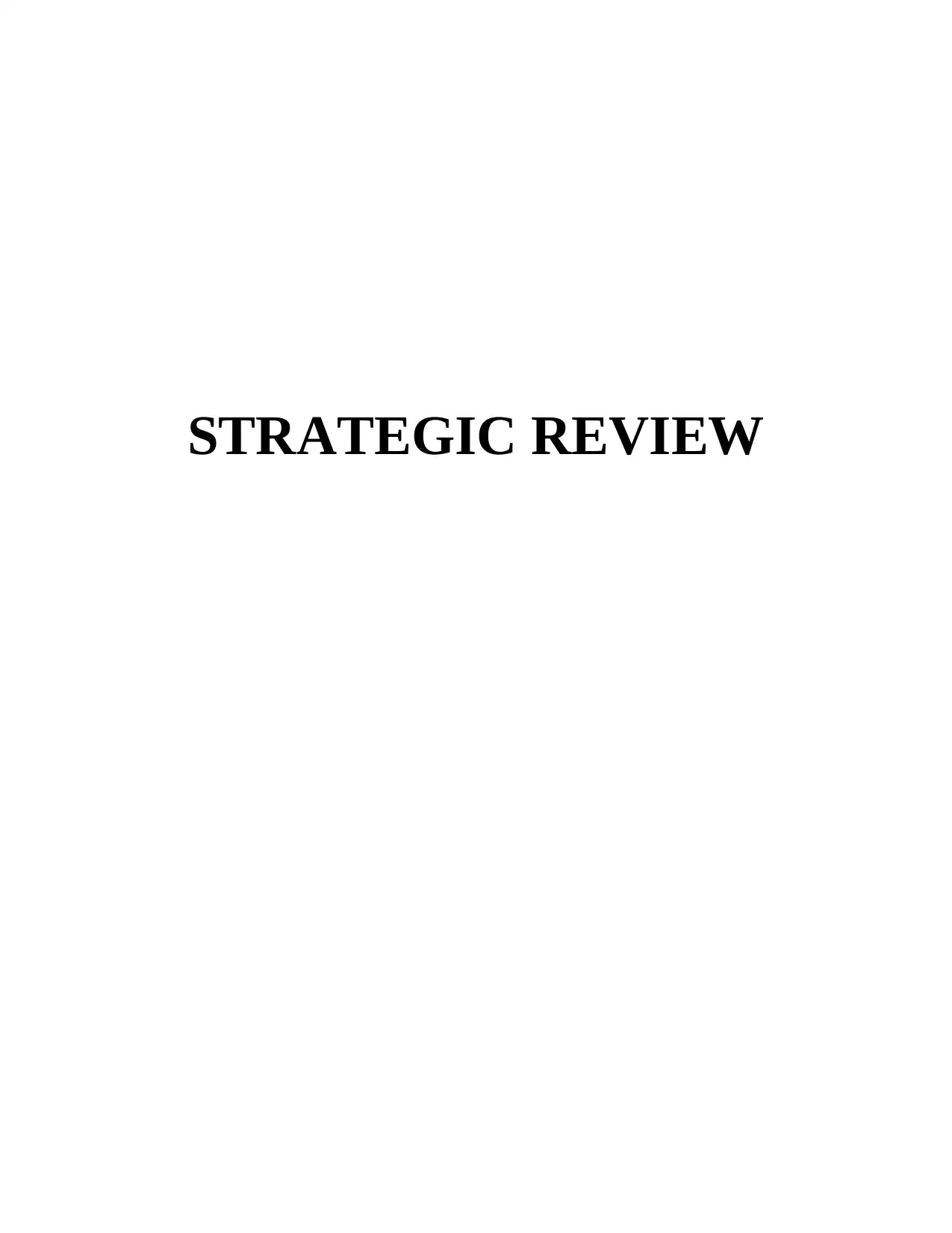
STRATEGIC REVIEW
Paraphrase This Document
Need a fresh take? Get an instant paraphrase of this document with our AI Paraphraser
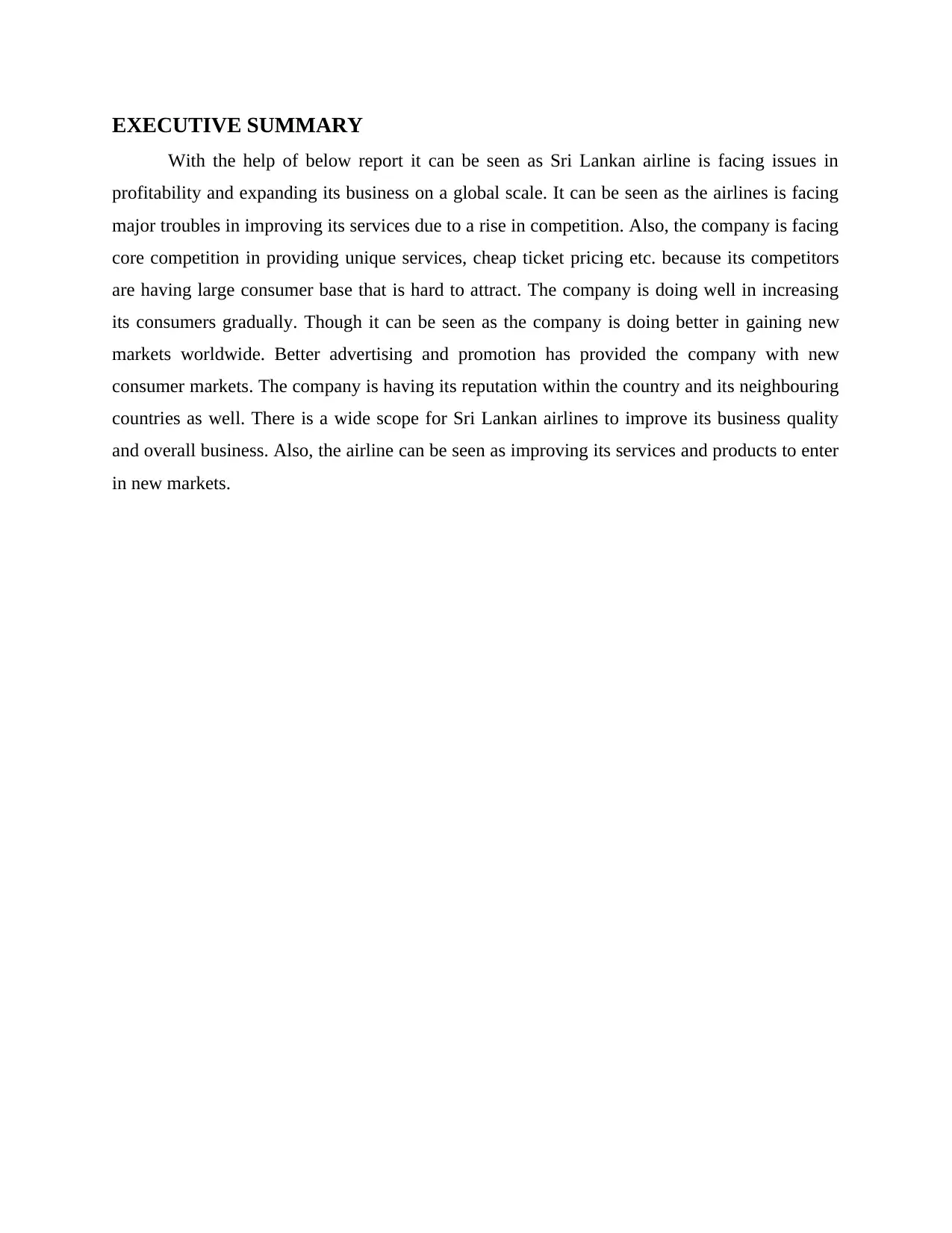
EXECUTIVE SUMMARY
With the help of below report it can be seen as Sri Lankan airline is facing issues in
profitability and expanding its business on a global scale. It can be seen as the airlines is facing
major troubles in improving its services due to a rise in competition. Also, the company is facing
core competition in providing unique services, cheap ticket pricing etc. because its competitors
are having large consumer base that is hard to attract. The company is doing well in increasing
its consumers gradually. Though it can be seen as the company is doing better in gaining new
markets worldwide. Better advertising and promotion has provided the company with new
consumer markets. The company is having its reputation within the country and its neighbouring
countries as well. There is a wide scope for Sri Lankan airlines to improve its business quality
and overall business. Also, the airline can be seen as improving its services and products to enter
in new markets.
With the help of below report it can be seen as Sri Lankan airline is facing issues in
profitability and expanding its business on a global scale. It can be seen as the airlines is facing
major troubles in improving its services due to a rise in competition. Also, the company is facing
core competition in providing unique services, cheap ticket pricing etc. because its competitors
are having large consumer base that is hard to attract. The company is doing well in increasing
its consumers gradually. Though it can be seen as the company is doing better in gaining new
markets worldwide. Better advertising and promotion has provided the company with new
consumer markets. The company is having its reputation within the country and its neighbouring
countries as well. There is a wide scope for Sri Lankan airlines to improve its business quality
and overall business. Also, the airline can be seen as improving its services and products to enter
in new markets.
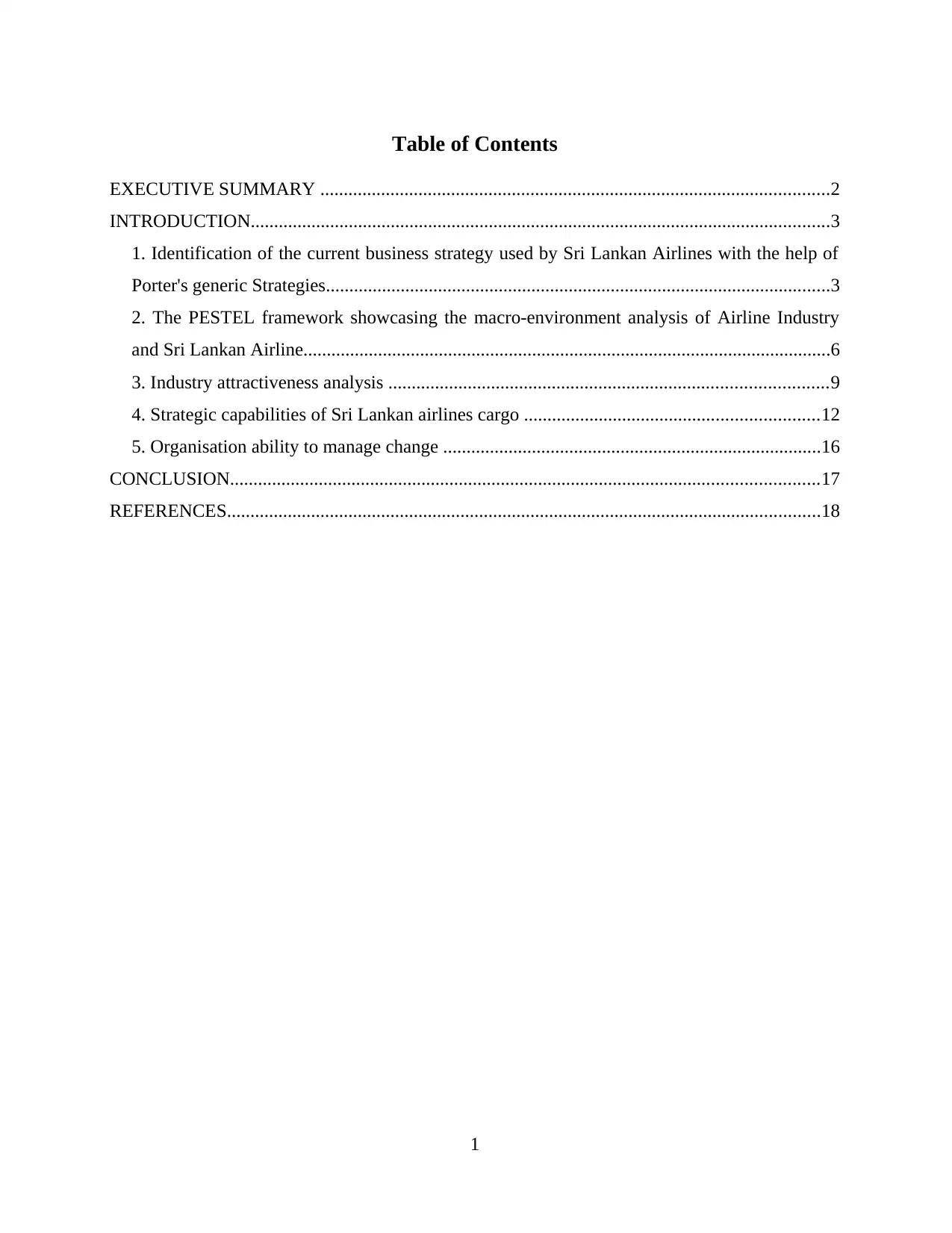
Table of Contents
EXECUTIVE SUMMARY .............................................................................................................2
INTRODUCTION............................................................................................................................3
1. Identification of the current business strategy used by Sri Lankan Airlines with the help of
Porter's generic Strategies............................................................................................................3
2. The PESTEL framework showcasing the macro-environment analysis of Airline Industry
and Sri Lankan Airline.................................................................................................................6
3. Industry attractiveness analysis ..............................................................................................9
4. Strategic capabilities of Sri Lankan airlines cargo ...............................................................12
5. Organisation ability to manage change .................................................................................16
CONCLUSION..............................................................................................................................17
REFERENCES...............................................................................................................................18
1
EXECUTIVE SUMMARY .............................................................................................................2
INTRODUCTION............................................................................................................................3
1. Identification of the current business strategy used by Sri Lankan Airlines with the help of
Porter's generic Strategies............................................................................................................3
2. The PESTEL framework showcasing the macro-environment analysis of Airline Industry
and Sri Lankan Airline.................................................................................................................6
3. Industry attractiveness analysis ..............................................................................................9
4. Strategic capabilities of Sri Lankan airlines cargo ...............................................................12
5. Organisation ability to manage change .................................................................................16
CONCLUSION..............................................................................................................................17
REFERENCES...............................................................................................................................18
1
⊘ This is a preview!⊘
Do you want full access?
Subscribe today to unlock all pages.

Trusted by 1+ million students worldwide
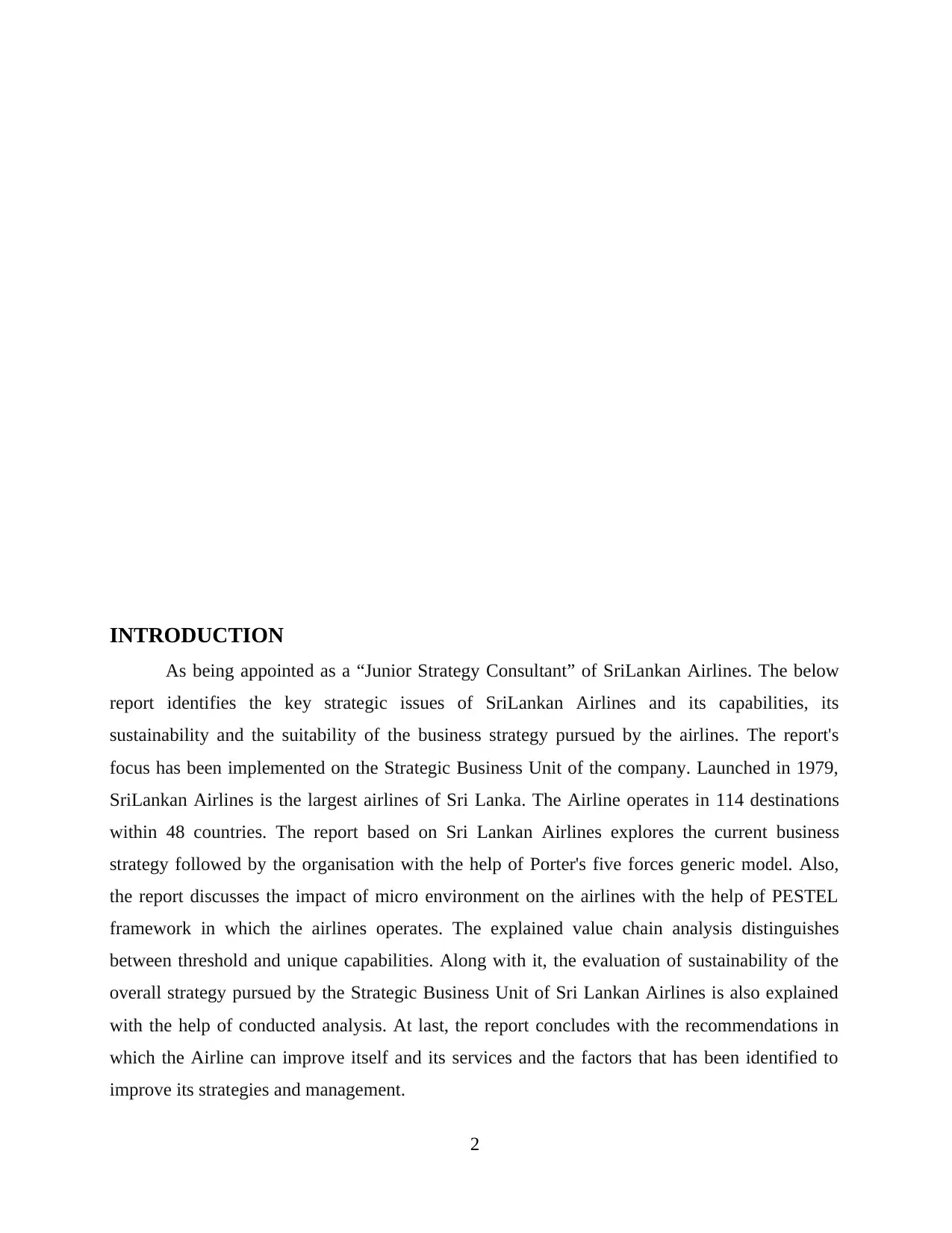
INTRODUCTION
As being appointed as a “Junior Strategy Consultant” of SriLankan Airlines. The below
report identifies the key strategic issues of SriLankan Airlines and its capabilities, its
sustainability and the suitability of the business strategy pursued by the airlines. The report's
focus has been implemented on the Strategic Business Unit of the company. Launched in 1979,
SriLankan Airlines is the largest airlines of Sri Lanka. The Airline operates in 114 destinations
within 48 countries. The report based on Sri Lankan Airlines explores the current business
strategy followed by the organisation with the help of Porter's five forces generic model. Also,
the report discusses the impact of micro environment on the airlines with the help of PESTEL
framework in which the airlines operates. The explained value chain analysis distinguishes
between threshold and unique capabilities. Along with it, the evaluation of sustainability of the
overall strategy pursued by the Strategic Business Unit of Sri Lankan Airlines is also explained
with the help of conducted analysis. At last, the report concludes with the recommendations in
which the Airline can improve itself and its services and the factors that has been identified to
improve its strategies and management.
2
As being appointed as a “Junior Strategy Consultant” of SriLankan Airlines. The below
report identifies the key strategic issues of SriLankan Airlines and its capabilities, its
sustainability and the suitability of the business strategy pursued by the airlines. The report's
focus has been implemented on the Strategic Business Unit of the company. Launched in 1979,
SriLankan Airlines is the largest airlines of Sri Lanka. The Airline operates in 114 destinations
within 48 countries. The report based on Sri Lankan Airlines explores the current business
strategy followed by the organisation with the help of Porter's five forces generic model. Also,
the report discusses the impact of micro environment on the airlines with the help of PESTEL
framework in which the airlines operates. The explained value chain analysis distinguishes
between threshold and unique capabilities. Along with it, the evaluation of sustainability of the
overall strategy pursued by the Strategic Business Unit of Sri Lankan Airlines is also explained
with the help of conducted analysis. At last, the report concludes with the recommendations in
which the Airline can improve itself and its services and the factors that has been identified to
improve its strategies and management.
2
Paraphrase This Document
Need a fresh take? Get an instant paraphrase of this document with our AI Paraphraser
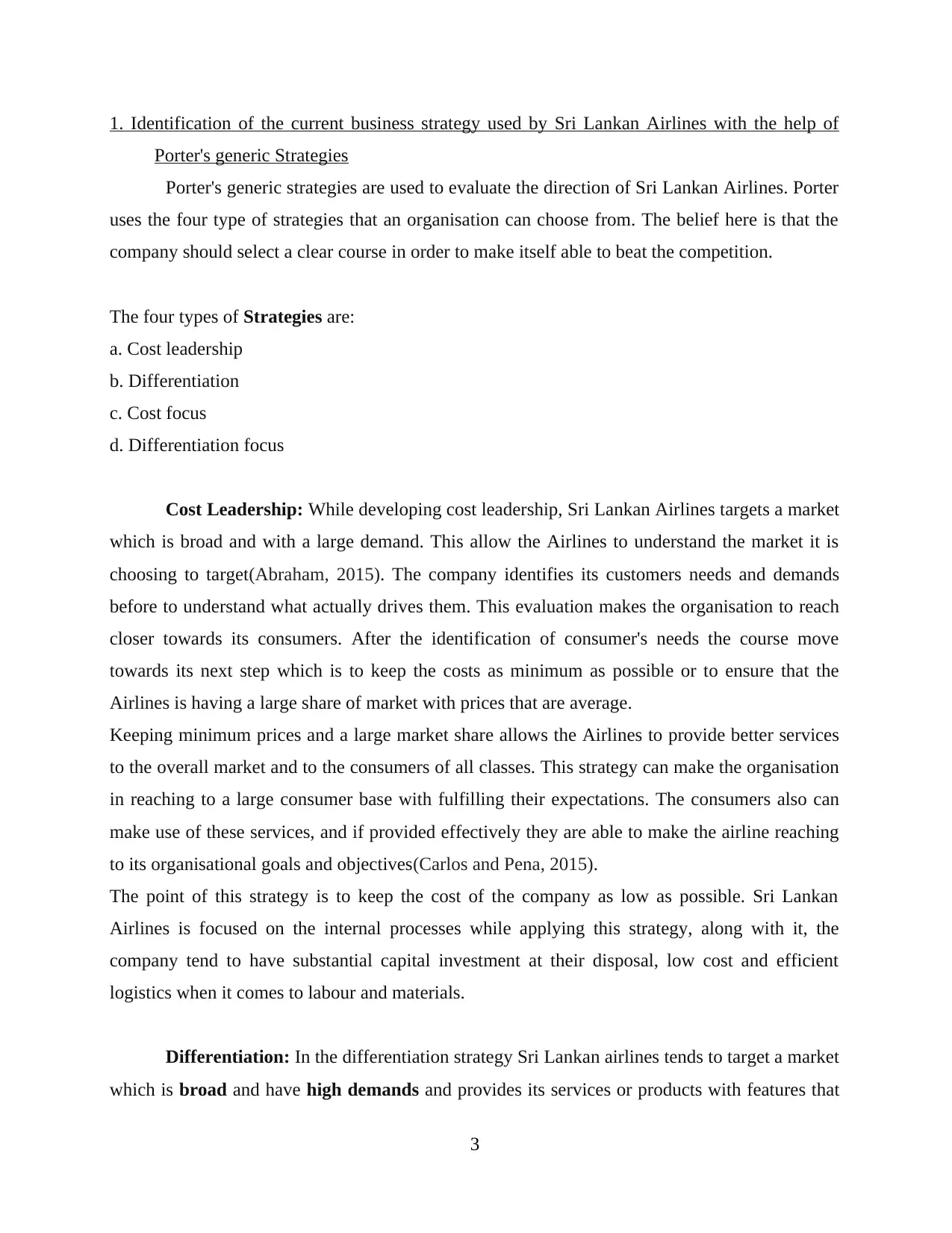
1. Identification of the current business strategy used by Sri Lankan Airlines with the help of
Porter's generic Strategies
Porter's generic strategies are used to evaluate the direction of Sri Lankan Airlines. Porter
uses the four type of strategies that an organisation can choose from. The belief here is that the
company should select a clear course in order to make itself able to beat the competition.
The four types of Strategies are:
a. Cost leadership
b. Differentiation
c. Cost focus
d. Differentiation focus
Cost Leadership: While developing cost leadership, Sri Lankan Airlines targets a market
which is broad and with a large demand. This allow the Airlines to understand the market it is
choosing to target(Abraham, 2015). The company identifies its customers needs and demands
before to understand what actually drives them. This evaluation makes the organisation to reach
closer towards its consumers. After the identification of consumer's needs the course move
towards its next step which is to keep the costs as minimum as possible or to ensure that the
Airlines is having a large share of market with prices that are average.
Keeping minimum prices and a large market share allows the Airlines to provide better services
to the overall market and to the consumers of all classes. This strategy can make the organisation
in reaching to a large consumer base with fulfilling their expectations. The consumers also can
make use of these services, and if provided effectively they are able to make the airline reaching
to its organisational goals and objectives(Carlos and Pena, 2015).
The point of this strategy is to keep the cost of the company as low as possible. Sri Lankan
Airlines is focused on the internal processes while applying this strategy, along with it, the
company tend to have substantial capital investment at their disposal, low cost and efficient
logistics when it comes to labour and materials.
Differentiation: In the differentiation strategy Sri Lankan airlines tends to target a market
which is broad and have high demands and provides its services or products with features that
3
Porter's generic Strategies
Porter's generic strategies are used to evaluate the direction of Sri Lankan Airlines. Porter
uses the four type of strategies that an organisation can choose from. The belief here is that the
company should select a clear course in order to make itself able to beat the competition.
The four types of Strategies are:
a. Cost leadership
b. Differentiation
c. Cost focus
d. Differentiation focus
Cost Leadership: While developing cost leadership, Sri Lankan Airlines targets a market
which is broad and with a large demand. This allow the Airlines to understand the market it is
choosing to target(Abraham, 2015). The company identifies its customers needs and demands
before to understand what actually drives them. This evaluation makes the organisation to reach
closer towards its consumers. After the identification of consumer's needs the course move
towards its next step which is to keep the costs as minimum as possible or to ensure that the
Airlines is having a large share of market with prices that are average.
Keeping minimum prices and a large market share allows the Airlines to provide better services
to the overall market and to the consumers of all classes. This strategy can make the organisation
in reaching to a large consumer base with fulfilling their expectations. The consumers also can
make use of these services, and if provided effectively they are able to make the airline reaching
to its organisational goals and objectives(Carlos and Pena, 2015).
The point of this strategy is to keep the cost of the company as low as possible. Sri Lankan
Airlines is focused on the internal processes while applying this strategy, along with it, the
company tend to have substantial capital investment at their disposal, low cost and efficient
logistics when it comes to labour and materials.
Differentiation: In the differentiation strategy Sri Lankan airlines tends to target a market
which is broad and have high demands and provides its services or products with features that
3
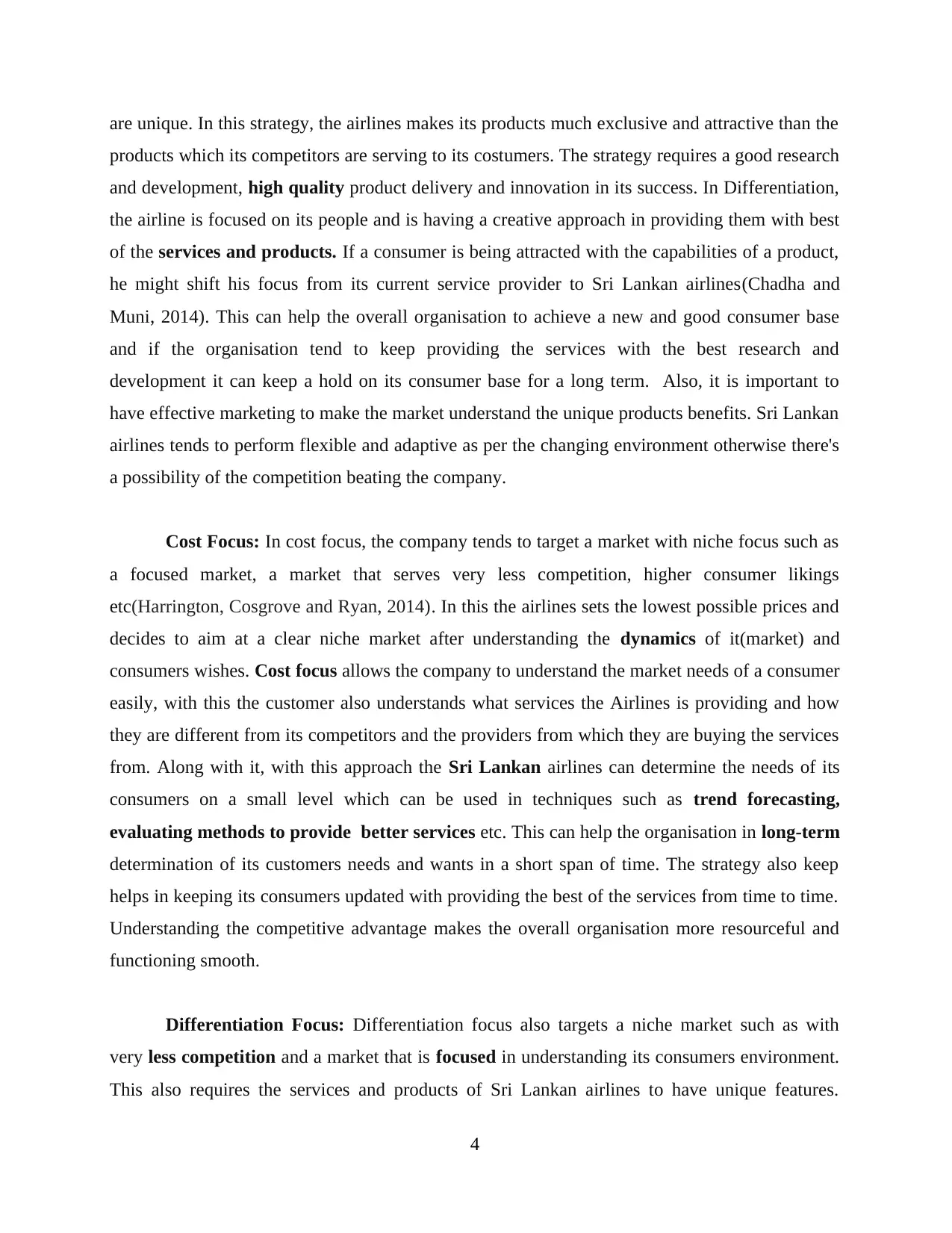
are unique. In this strategy, the airlines makes its products much exclusive and attractive than the
products which its competitors are serving to its costumers. The strategy requires a good research
and development, high quality product delivery and innovation in its success. In Differentiation,
the airline is focused on its people and is having a creative approach in providing them with best
of the services and products. If a consumer is being attracted with the capabilities of a product,
he might shift his focus from its current service provider to Sri Lankan airlines(Chadha and
Muni, 2014). This can help the overall organisation to achieve a new and good consumer base
and if the organisation tend to keep providing the services with the best research and
development it can keep a hold on its consumer base for a long term. Also, it is important to
have effective marketing to make the market understand the unique products benefits. Sri Lankan
airlines tends to perform flexible and adaptive as per the changing environment otherwise there's
a possibility of the competition beating the company.
Cost Focus: In cost focus, the company tends to target a market with niche focus such as
a focused market, a market that serves very less competition, higher consumer likings
etc(Harrington, Cosgrove and Ryan, 2014). In this the airlines sets the lowest possible prices and
decides to aim at a clear niche market after understanding the dynamics of it(market) and
consumers wishes. Cost focus allows the company to understand the market needs of a consumer
easily, with this the customer also understands what services the Airlines is providing and how
they are different from its competitors and the providers from which they are buying the services
from. Along with it, with this approach the Sri Lankan airlines can determine the needs of its
consumers on a small level which can be used in techniques such as trend forecasting,
evaluating methods to provide better services etc. This can help the organisation in long-term
determination of its customers needs and wants in a short span of time. The strategy also keep
helps in keeping its consumers updated with providing the best of the services from time to time.
Understanding the competitive advantage makes the overall organisation more resourceful and
functioning smooth.
Differentiation Focus: Differentiation focus also targets a niche market such as with
very less competition and a market that is focused in understanding its consumers environment.
This also requires the services and products of Sri Lankan airlines to have unique features.
4
products which its competitors are serving to its costumers. The strategy requires a good research
and development, high quality product delivery and innovation in its success. In Differentiation,
the airline is focused on its people and is having a creative approach in providing them with best
of the services and products. If a consumer is being attracted with the capabilities of a product,
he might shift his focus from its current service provider to Sri Lankan airlines(Chadha and
Muni, 2014). This can help the overall organisation to achieve a new and good consumer base
and if the organisation tend to keep providing the services with the best research and
development it can keep a hold on its consumer base for a long term. Also, it is important to
have effective marketing to make the market understand the unique products benefits. Sri Lankan
airlines tends to perform flexible and adaptive as per the changing environment otherwise there's
a possibility of the competition beating the company.
Cost Focus: In cost focus, the company tends to target a market with niche focus such as
a focused market, a market that serves very less competition, higher consumer likings
etc(Harrington, Cosgrove and Ryan, 2014). In this the airlines sets the lowest possible prices and
decides to aim at a clear niche market after understanding the dynamics of it(market) and
consumers wishes. Cost focus allows the company to understand the market needs of a consumer
easily, with this the customer also understands what services the Airlines is providing and how
they are different from its competitors and the providers from which they are buying the services
from. Along with it, with this approach the Sri Lankan airlines can determine the needs of its
consumers on a small level which can be used in techniques such as trend forecasting,
evaluating methods to provide better services etc. This can help the organisation in long-term
determination of its customers needs and wants in a short span of time. The strategy also keep
helps in keeping its consumers updated with providing the best of the services from time to time.
Understanding the competitive advantage makes the overall organisation more resourceful and
functioning smooth.
Differentiation Focus: Differentiation focus also targets a niche market such as with
very less competition and a market that is focused in understanding its consumers environment.
This also requires the services and products of Sri Lankan airlines to have unique features.
4
⊘ This is a preview!⊘
Do you want full access?
Subscribe today to unlock all pages.

Trusted by 1+ million students worldwide
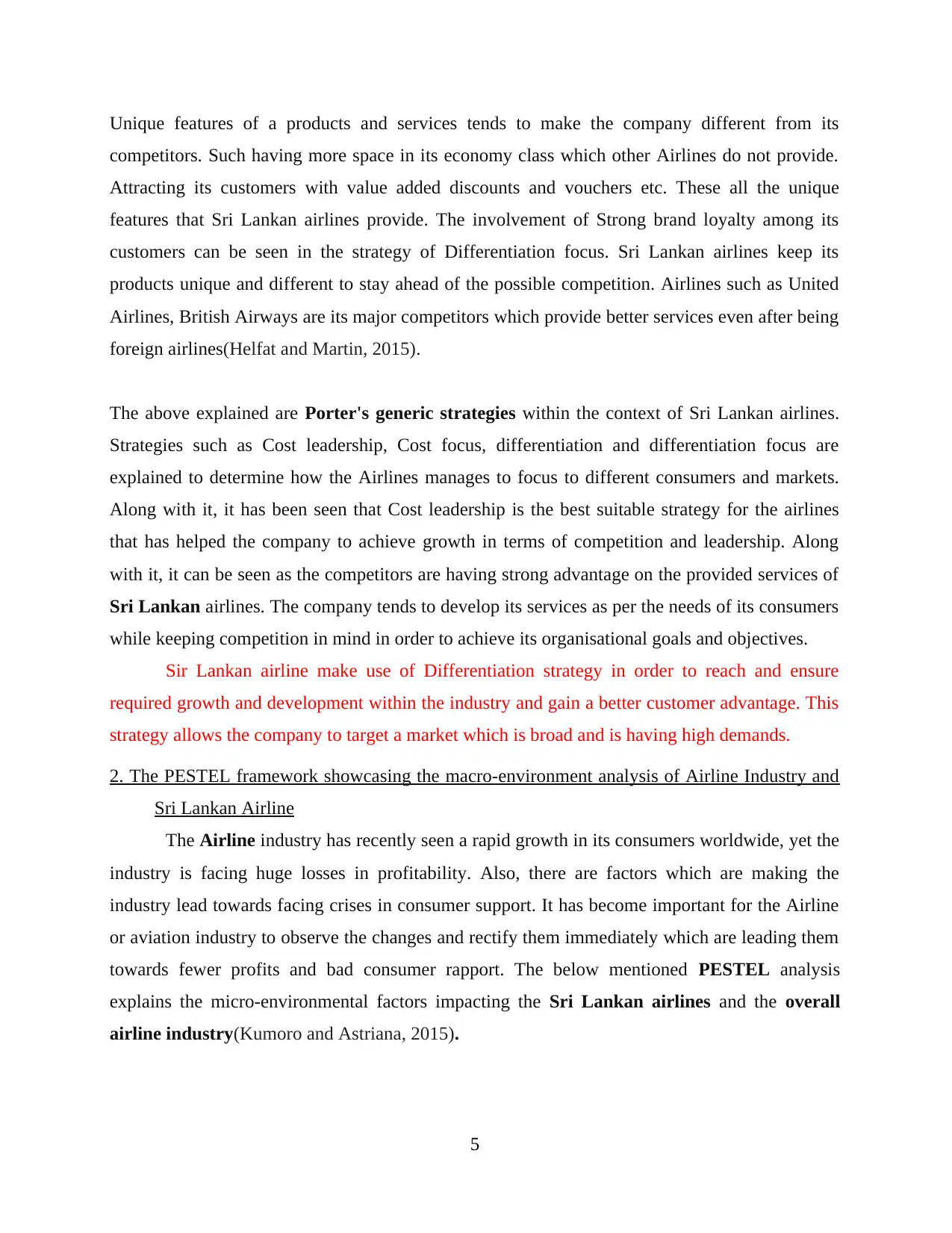
Unique features of a products and services tends to make the company different from its
competitors. Such having more space in its economy class which other Airlines do not provide.
Attracting its customers with value added discounts and vouchers etc. These all the unique
features that Sri Lankan airlines provide. The involvement of Strong brand loyalty among its
customers can be seen in the strategy of Differentiation focus. Sri Lankan airlines keep its
products unique and different to stay ahead of the possible competition. Airlines such as United
Airlines, British Airways are its major competitors which provide better services even after being
foreign airlines(Helfat and Martin, 2015).
The above explained are Porter's generic strategies within the context of Sri Lankan airlines.
Strategies such as Cost leadership, Cost focus, differentiation and differentiation focus are
explained to determine how the Airlines manages to focus to different consumers and markets.
Along with it, it has been seen that Cost leadership is the best suitable strategy for the airlines
that has helped the company to achieve growth in terms of competition and leadership. Along
with it, it can be seen as the competitors are having strong advantage on the provided services of
Sri Lankan airlines. The company tends to develop its services as per the needs of its consumers
while keeping competition in mind in order to achieve its organisational goals and objectives.
Sir Lankan airline make use of Differentiation strategy in order to reach and ensure
required growth and development within the industry and gain a better customer advantage. This
strategy allows the company to target a market which is broad and is having high demands.
2. The PESTEL framework showcasing the macro-environment analysis of Airline Industry and
Sri Lankan Airline
The Airline industry has recently seen a rapid growth in its consumers worldwide, yet the
industry is facing huge losses in profitability. Also, there are factors which are making the
industry lead towards facing crises in consumer support. It has become important for the Airline
or aviation industry to observe the changes and rectify them immediately which are leading them
towards fewer profits and bad consumer rapport. The below mentioned PESTEL analysis
explains the micro-environmental factors impacting the Sri Lankan airlines and the overall
airline industry(Kumoro and Astriana, 2015).
5
competitors. Such having more space in its economy class which other Airlines do not provide.
Attracting its customers with value added discounts and vouchers etc. These all the unique
features that Sri Lankan airlines provide. The involvement of Strong brand loyalty among its
customers can be seen in the strategy of Differentiation focus. Sri Lankan airlines keep its
products unique and different to stay ahead of the possible competition. Airlines such as United
Airlines, British Airways are its major competitors which provide better services even after being
foreign airlines(Helfat and Martin, 2015).
The above explained are Porter's generic strategies within the context of Sri Lankan airlines.
Strategies such as Cost leadership, Cost focus, differentiation and differentiation focus are
explained to determine how the Airlines manages to focus to different consumers and markets.
Along with it, it has been seen that Cost leadership is the best suitable strategy for the airlines
that has helped the company to achieve growth in terms of competition and leadership. Along
with it, it can be seen as the competitors are having strong advantage on the provided services of
Sri Lankan airlines. The company tends to develop its services as per the needs of its consumers
while keeping competition in mind in order to achieve its organisational goals and objectives.
Sir Lankan airline make use of Differentiation strategy in order to reach and ensure
required growth and development within the industry and gain a better customer advantage. This
strategy allows the company to target a market which is broad and is having high demands.
2. The PESTEL framework showcasing the macro-environment analysis of Airline Industry and
Sri Lankan Airline
The Airline industry has recently seen a rapid growth in its consumers worldwide, yet the
industry is facing huge losses in profitability. Also, there are factors which are making the
industry lead towards facing crises in consumer support. It has become important for the Airline
or aviation industry to observe the changes and rectify them immediately which are leading them
towards fewer profits and bad consumer rapport. The below mentioned PESTEL analysis
explains the micro-environmental factors impacting the Sri Lankan airlines and the overall
airline industry(Kumoro and Astriana, 2015).
5
Paraphrase This Document
Need a fresh take? Get an instant paraphrase of this document with our AI Paraphraser
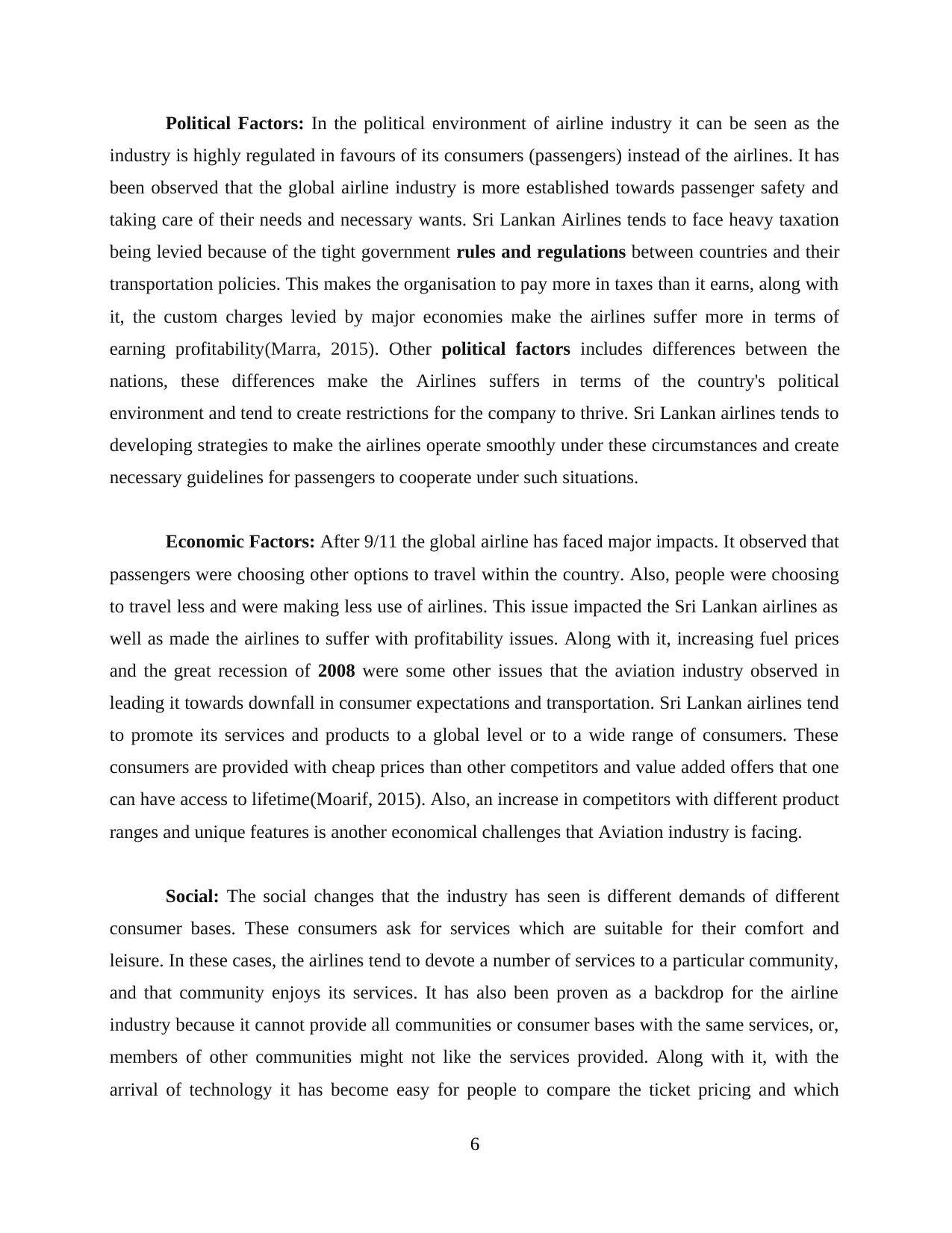
Political Factors: In the political environment of airline industry it can be seen as the
industry is highly regulated in favours of its consumers (passengers) instead of the airlines. It has
been observed that the global airline industry is more established towards passenger safety and
taking care of their needs and necessary wants. Sri Lankan Airlines tends to face heavy taxation
being levied because of the tight government rules and regulations between countries and their
transportation policies. This makes the organisation to pay more in taxes than it earns, along with
it, the custom charges levied by major economies make the airlines suffer more in terms of
earning profitability(Marra, 2015). Other political factors includes differences between the
nations, these differences make the Airlines suffers in terms of the country's political
environment and tend to create restrictions for the company to thrive. Sri Lankan airlines tends to
developing strategies to make the airlines operate smoothly under these circumstances and create
necessary guidelines for passengers to cooperate under such situations.
Economic Factors: After 9/11 the global airline has faced major impacts. It observed that
passengers were choosing other options to travel within the country. Also, people were choosing
to travel less and were making less use of airlines. This issue impacted the Sri Lankan airlines as
well as made the airlines to suffer with profitability issues. Along with it, increasing fuel prices
and the great recession of 2008 were some other issues that the aviation industry observed in
leading it towards downfall in consumer expectations and transportation. Sri Lankan airlines tend
to promote its services and products to a global level or to a wide range of consumers. These
consumers are provided with cheap prices than other competitors and value added offers that one
can have access to lifetime(Moarif, 2015). Also, an increase in competitors with different product
ranges and unique features is another economical challenges that Aviation industry is facing.
Social: The social changes that the industry has seen is different demands of different
consumer bases. These consumers ask for services which are suitable for their comfort and
leisure. In these cases, the airlines tend to devote a number of services to a particular community,
and that community enjoys its services. It has also been proven as a backdrop for the airline
industry because it cannot provide all communities or consumer bases with the same services, or,
members of other communities might not like the services provided. Along with it, with the
arrival of technology it has become easy for people to compare the ticket pricing and which
6
industry is highly regulated in favours of its consumers (passengers) instead of the airlines. It has
been observed that the global airline industry is more established towards passenger safety and
taking care of their needs and necessary wants. Sri Lankan Airlines tends to face heavy taxation
being levied because of the tight government rules and regulations between countries and their
transportation policies. This makes the organisation to pay more in taxes than it earns, along with
it, the custom charges levied by major economies make the airlines suffer more in terms of
earning profitability(Marra, 2015). Other political factors includes differences between the
nations, these differences make the Airlines suffers in terms of the country's political
environment and tend to create restrictions for the company to thrive. Sri Lankan airlines tends to
developing strategies to make the airlines operate smoothly under these circumstances and create
necessary guidelines for passengers to cooperate under such situations.
Economic Factors: After 9/11 the global airline has faced major impacts. It observed that
passengers were choosing other options to travel within the country. Also, people were choosing
to travel less and were making less use of airlines. This issue impacted the Sri Lankan airlines as
well as made the airlines to suffer with profitability issues. Along with it, increasing fuel prices
and the great recession of 2008 were some other issues that the aviation industry observed in
leading it towards downfall in consumer expectations and transportation. Sri Lankan airlines tend
to promote its services and products to a global level or to a wide range of consumers. These
consumers are provided with cheap prices than other competitors and value added offers that one
can have access to lifetime(Moarif, 2015). Also, an increase in competitors with different product
ranges and unique features is another economical challenges that Aviation industry is facing.
Social: The social changes that the industry has seen is different demands of different
consumer bases. These consumers ask for services which are suitable for their comfort and
leisure. In these cases, the airlines tend to devote a number of services to a particular community,
and that community enjoys its services. It has also been proven as a backdrop for the airline
industry because it cannot provide all communities or consumer bases with the same services, or,
members of other communities might not like the services provided. Along with it, with the
arrival of technology it has become easy for people to compare the ticket pricing and which
6
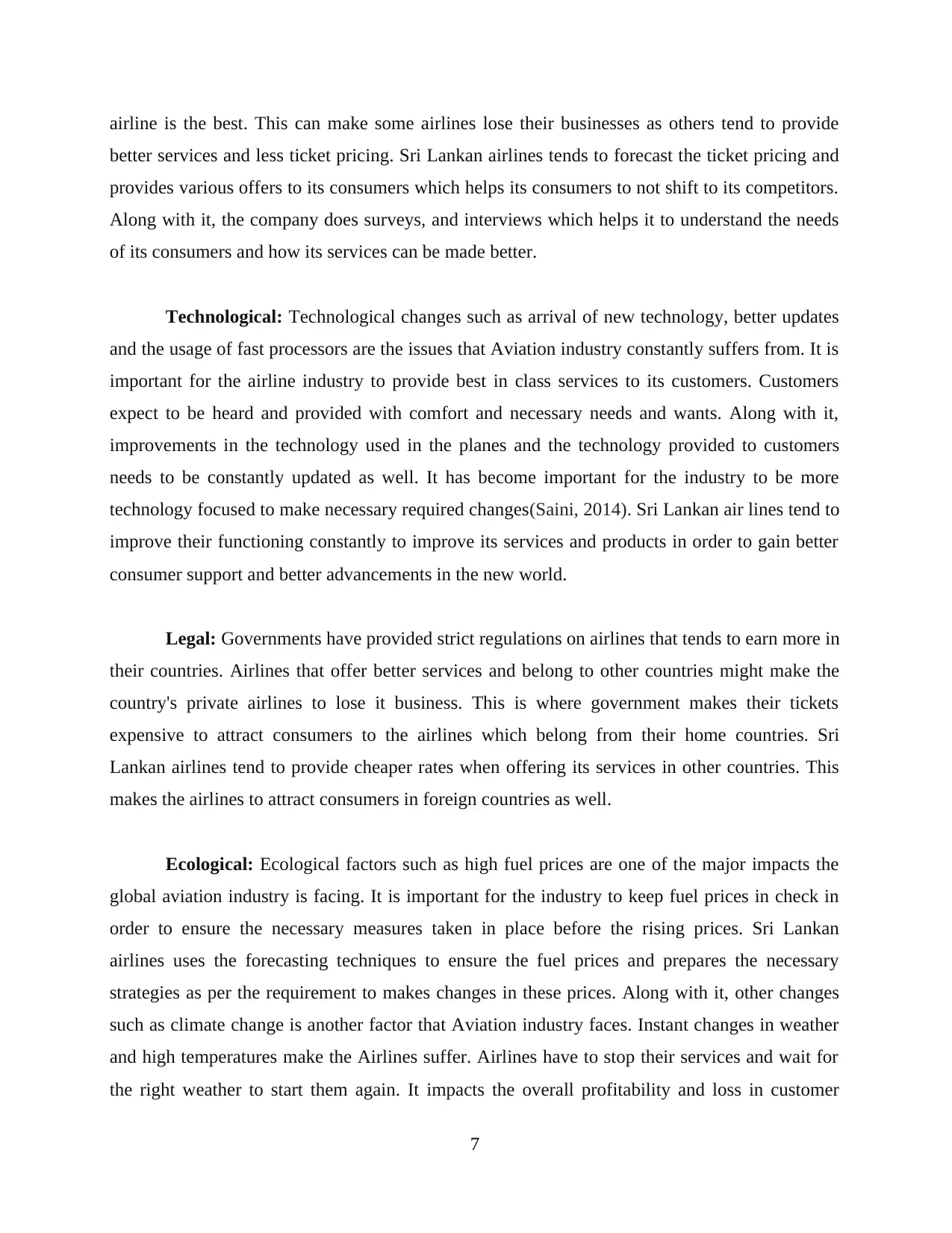
airline is the best. This can make some airlines lose their businesses as others tend to provide
better services and less ticket pricing. Sri Lankan airlines tends to forecast the ticket pricing and
provides various offers to its consumers which helps its consumers to not shift to its competitors.
Along with it, the company does surveys, and interviews which helps it to understand the needs
of its consumers and how its services can be made better.
Technological: Technological changes such as arrival of new technology, better updates
and the usage of fast processors are the issues that Aviation industry constantly suffers from. It is
important for the airline industry to provide best in class services to its customers. Customers
expect to be heard and provided with comfort and necessary needs and wants. Along with it,
improvements in the technology used in the planes and the technology provided to customers
needs to be constantly updated as well. It has become important for the industry to be more
technology focused to make necessary required changes(Saini, 2014). Sri Lankan air lines tend to
improve their functioning constantly to improve its services and products in order to gain better
consumer support and better advancements in the new world.
Legal: Governments have provided strict regulations on airlines that tends to earn more in
their countries. Airlines that offer better services and belong to other countries might make the
country's private airlines to lose it business. This is where government makes their tickets
expensive to attract consumers to the airlines which belong from their home countries. Sri
Lankan airlines tend to provide cheaper rates when offering its services in other countries. This
makes the airlines to attract consumers in foreign countries as well.
Ecological: Ecological factors such as high fuel prices are one of the major impacts the
global aviation industry is facing. It is important for the industry to keep fuel prices in check in
order to ensure the necessary measures taken in place before the rising prices. Sri Lankan
airlines uses the forecasting techniques to ensure the fuel prices and prepares the necessary
strategies as per the requirement to makes changes in these prices. Along with it, other changes
such as climate change is another factor that Aviation industry faces. Instant changes in weather
and high temperatures make the Airlines suffer. Airlines have to stop their services and wait for
the right weather to start them again. It impacts the overall profitability and loss in customer
7
better services and less ticket pricing. Sri Lankan airlines tends to forecast the ticket pricing and
provides various offers to its consumers which helps its consumers to not shift to its competitors.
Along with it, the company does surveys, and interviews which helps it to understand the needs
of its consumers and how its services can be made better.
Technological: Technological changes such as arrival of new technology, better updates
and the usage of fast processors are the issues that Aviation industry constantly suffers from. It is
important for the airline industry to provide best in class services to its customers. Customers
expect to be heard and provided with comfort and necessary needs and wants. Along with it,
improvements in the technology used in the planes and the technology provided to customers
needs to be constantly updated as well. It has become important for the industry to be more
technology focused to make necessary required changes(Saini, 2014). Sri Lankan air lines tend to
improve their functioning constantly to improve its services and products in order to gain better
consumer support and better advancements in the new world.
Legal: Governments have provided strict regulations on airlines that tends to earn more in
their countries. Airlines that offer better services and belong to other countries might make the
country's private airlines to lose it business. This is where government makes their tickets
expensive to attract consumers to the airlines which belong from their home countries. Sri
Lankan airlines tend to provide cheaper rates when offering its services in other countries. This
makes the airlines to attract consumers in foreign countries as well.
Ecological: Ecological factors such as high fuel prices are one of the major impacts the
global aviation industry is facing. It is important for the industry to keep fuel prices in check in
order to ensure the necessary measures taken in place before the rising prices. Sri Lankan
airlines uses the forecasting techniques to ensure the fuel prices and prepares the necessary
strategies as per the requirement to makes changes in these prices. Along with it, other changes
such as climate change is another factor that Aviation industry faces. Instant changes in weather
and high temperatures make the Airlines suffer. Airlines have to stop their services and wait for
the right weather to start them again. It impacts the overall profitability and loss in customer
7
⊘ This is a preview!⊘
Do you want full access?
Subscribe today to unlock all pages.

Trusted by 1+ million students worldwide
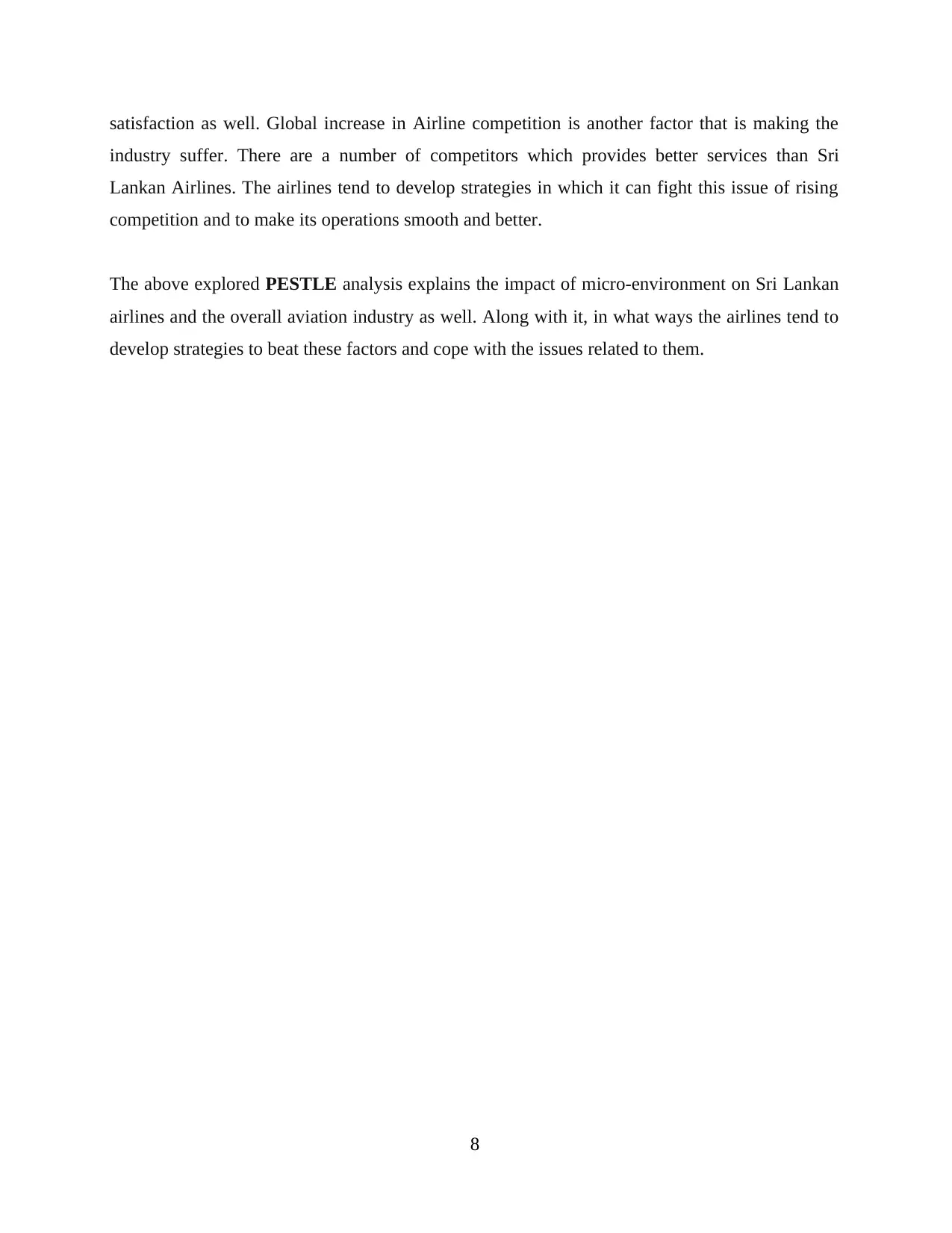
satisfaction as well. Global increase in Airline competition is another factor that is making the
industry suffer. There are a number of competitors which provides better services than Sri
Lankan Airlines. The airlines tend to develop strategies in which it can fight this issue of rising
competition and to make its operations smooth and better.
The above explored PESTLE analysis explains the impact of micro-environment on Sri Lankan
airlines and the overall aviation industry as well. Along with it, in what ways the airlines tend to
develop strategies to beat these factors and cope with the issues related to them.
8
industry suffer. There are a number of competitors which provides better services than Sri
Lankan Airlines. The airlines tend to develop strategies in which it can fight this issue of rising
competition and to make its operations smooth and better.
The above explored PESTLE analysis explains the impact of micro-environment on Sri Lankan
airlines and the overall aviation industry as well. Along with it, in what ways the airlines tend to
develop strategies to beat these factors and cope with the issues related to them.
8
Paraphrase This Document
Need a fresh take? Get an instant paraphrase of this document with our AI Paraphraser
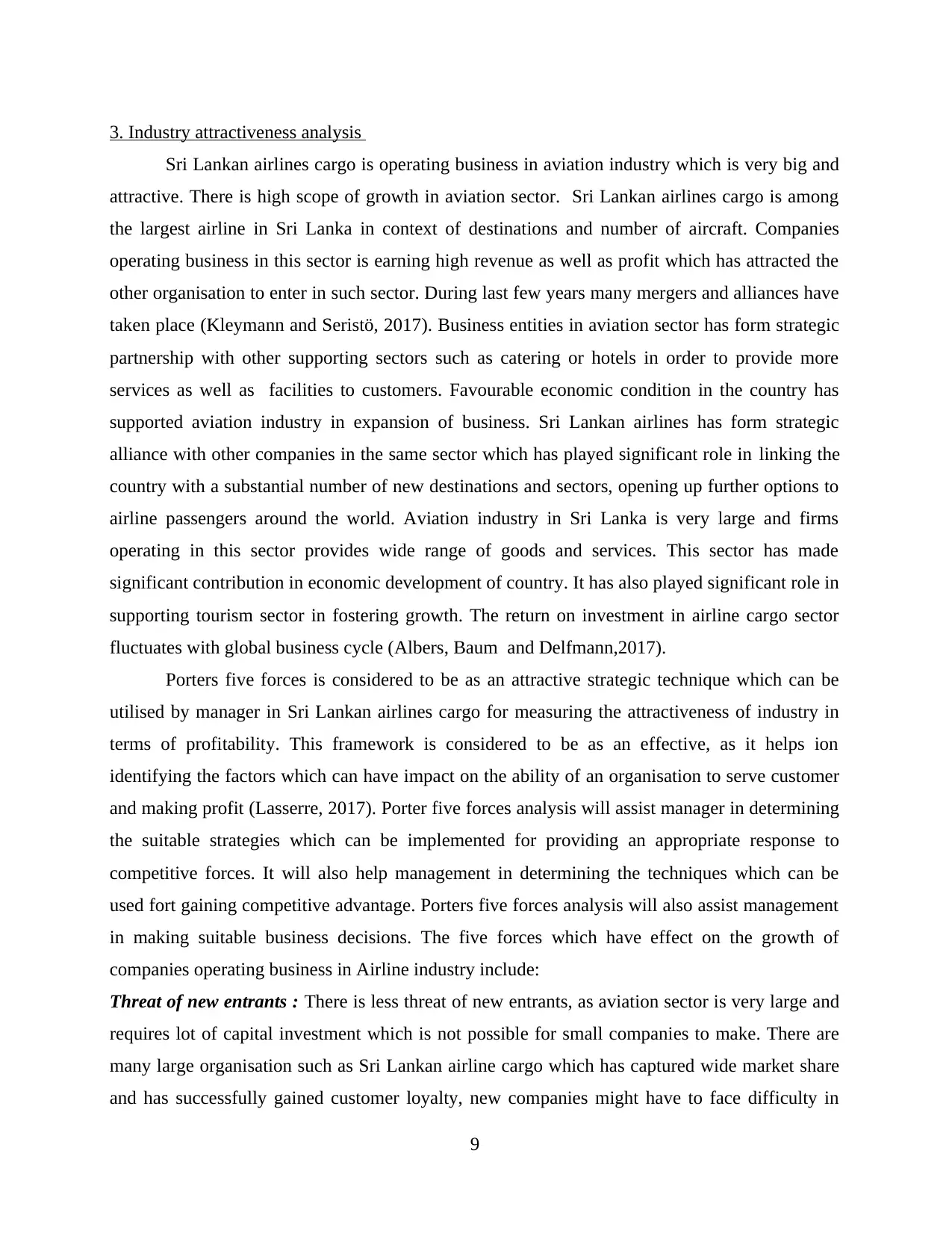
3. Industry attractiveness analysis
Sri Lankan airlines cargo is operating business in aviation industry which is very big and
attractive. There is high scope of growth in aviation sector. Sri Lankan airlines cargo is among
the largest airline in Sri Lanka in context of destinations and number of aircraft. Companies
operating business in this sector is earning high revenue as well as profit which has attracted the
other organisation to enter in such sector. During last few years many mergers and alliances have
taken place (Kleymann and Seristö, 2017). Business entities in aviation sector has form strategic
partnership with other supporting sectors such as catering or hotels in order to provide more
services as well as facilities to customers. Favourable economic condition in the country has
supported aviation industry in expansion of business. Sri Lankan airlines has form strategic
alliance with other companies in the same sector which has played significant role in linking the
country with a substantial number of new destinations and sectors, opening up further options to
airline passengers around the world. Aviation industry in Sri Lanka is very large and firms
operating in this sector provides wide range of goods and services. This sector has made
significant contribution in economic development of country. It has also played significant role in
supporting tourism sector in fostering growth. The return on investment in airline cargo sector
fluctuates with global business cycle (Albers, Baum and Delfmann,2017).
Porters five forces is considered to be as an attractive strategic technique which can be
utilised by manager in Sri Lankan airlines cargo for measuring the attractiveness of industry in
terms of profitability. This framework is considered to be as an effective, as it helps ion
identifying the factors which can have impact on the ability of an organisation to serve customer
and making profit (Lasserre, 2017). Porter five forces analysis will assist manager in determining
the suitable strategies which can be implemented for providing an appropriate response to
competitive forces. It will also help management in determining the techniques which can be
used fort gaining competitive advantage. Porters five forces analysis will also assist management
in making suitable business decisions. The five forces which have effect on the growth of
companies operating business in Airline industry include:
Threat of new entrants : There is less threat of new entrants, as aviation sector is very large and
requires lot of capital investment which is not possible for small companies to make. There are
many large organisation such as Sri Lankan airline cargo which has captured wide market share
and has successfully gained customer loyalty, new companies might have to face difficulty in
9
Sri Lankan airlines cargo is operating business in aviation industry which is very big and
attractive. There is high scope of growth in aviation sector. Sri Lankan airlines cargo is among
the largest airline in Sri Lanka in context of destinations and number of aircraft. Companies
operating business in this sector is earning high revenue as well as profit which has attracted the
other organisation to enter in such sector. During last few years many mergers and alliances have
taken place (Kleymann and Seristö, 2017). Business entities in aviation sector has form strategic
partnership with other supporting sectors such as catering or hotels in order to provide more
services as well as facilities to customers. Favourable economic condition in the country has
supported aviation industry in expansion of business. Sri Lankan airlines has form strategic
alliance with other companies in the same sector which has played significant role in linking the
country with a substantial number of new destinations and sectors, opening up further options to
airline passengers around the world. Aviation industry in Sri Lanka is very large and firms
operating in this sector provides wide range of goods and services. This sector has made
significant contribution in economic development of country. It has also played significant role in
supporting tourism sector in fostering growth. The return on investment in airline cargo sector
fluctuates with global business cycle (Albers, Baum and Delfmann,2017).
Porters five forces is considered to be as an attractive strategic technique which can be
utilised by manager in Sri Lankan airlines cargo for measuring the attractiveness of industry in
terms of profitability. This framework is considered to be as an effective, as it helps ion
identifying the factors which can have impact on the ability of an organisation to serve customer
and making profit (Lasserre, 2017). Porter five forces analysis will assist manager in determining
the suitable strategies which can be implemented for providing an appropriate response to
competitive forces. It will also help management in determining the techniques which can be
used fort gaining competitive advantage. Porters five forces analysis will also assist management
in making suitable business decisions. The five forces which have effect on the growth of
companies operating business in Airline industry include:
Threat of new entrants : There is less threat of new entrants, as aviation sector is very large and
requires lot of capital investment which is not possible for small companies to make. There are
many large organisation such as Sri Lankan airline cargo which has captured wide market share
and has successfully gained customer loyalty, new companies might have to face difficulty in
9
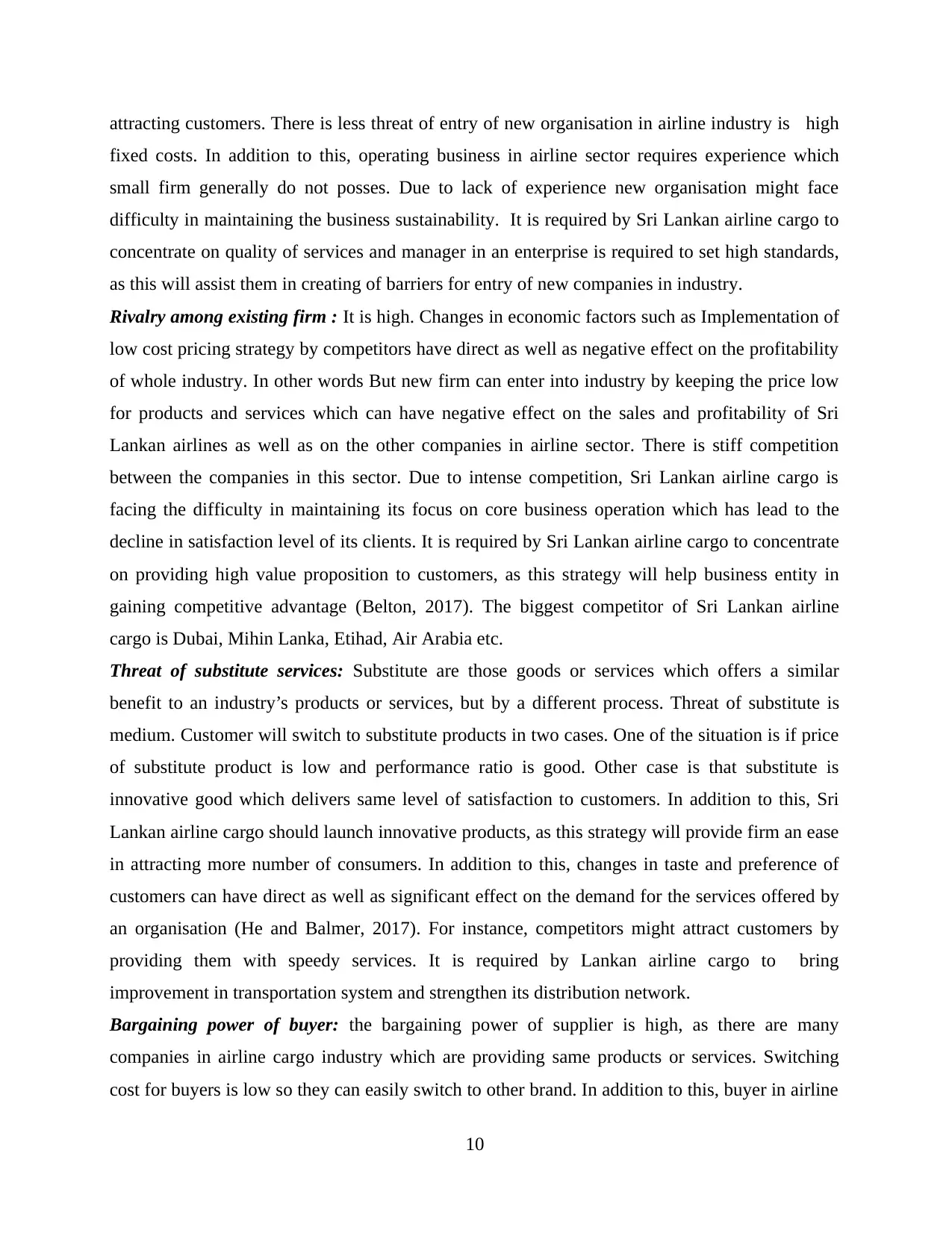
attracting customers. There is less threat of entry of new organisation in airline industry is high
fixed costs. In addition to this, operating business in airline sector requires experience which
small firm generally do not posses. Due to lack of experience new organisation might face
difficulty in maintaining the business sustainability. It is required by Sri Lankan airline cargo to
concentrate on quality of services and manager in an enterprise is required to set high standards,
as this will assist them in creating of barriers for entry of new companies in industry.
Rivalry among existing firm : It is high. Changes in economic factors such as Implementation of
low cost pricing strategy by competitors have direct as well as negative effect on the profitability
of whole industry. In other words But new firm can enter into industry by keeping the price low
for products and services which can have negative effect on the sales and profitability of Sri
Lankan airlines as well as on the other companies in airline sector. There is stiff competition
between the companies in this sector. Due to intense competition, Sri Lankan airline cargo is
facing the difficulty in maintaining its focus on core business operation which has lead to the
decline in satisfaction level of its clients. It is required by Sri Lankan airline cargo to concentrate
on providing high value proposition to customers, as this strategy will help business entity in
gaining competitive advantage (Belton, 2017). The biggest competitor of Sri Lankan airline
cargo is Dubai, Mihin Lanka, Etihad, Air Arabia etc.
Threat of substitute services: Substitute are those goods or services which offers a similar
benefit to an industry’s products or services, but by a different process. Threat of substitute is
medium. Customer will switch to substitute products in two cases. One of the situation is if price
of substitute product is low and performance ratio is good. Other case is that substitute is
innovative good which delivers same level of satisfaction to customers. In addition to this, Sri
Lankan airline cargo should launch innovative products, as this strategy will provide firm an ease
in attracting more number of consumers. In addition to this, changes in taste and preference of
customers can have direct as well as significant effect on the demand for the services offered by
an organisation (He and Balmer, 2017). For instance, competitors might attract customers by
providing them with speedy services. It is required by Lankan airline cargo to bring
improvement in transportation system and strengthen its distribution network.
Bargaining power of buyer: the bargaining power of supplier is high, as there are many
companies in airline cargo industry which are providing same products or services. Switching
cost for buyers is low so they can easily switch to other brand. In addition to this, buyer in airline
10
fixed costs. In addition to this, operating business in airline sector requires experience which
small firm generally do not posses. Due to lack of experience new organisation might face
difficulty in maintaining the business sustainability. It is required by Sri Lankan airline cargo to
concentrate on quality of services and manager in an enterprise is required to set high standards,
as this will assist them in creating of barriers for entry of new companies in industry.
Rivalry among existing firm : It is high. Changes in economic factors such as Implementation of
low cost pricing strategy by competitors have direct as well as negative effect on the profitability
of whole industry. In other words But new firm can enter into industry by keeping the price low
for products and services which can have negative effect on the sales and profitability of Sri
Lankan airlines as well as on the other companies in airline sector. There is stiff competition
between the companies in this sector. Due to intense competition, Sri Lankan airline cargo is
facing the difficulty in maintaining its focus on core business operation which has lead to the
decline in satisfaction level of its clients. It is required by Sri Lankan airline cargo to concentrate
on providing high value proposition to customers, as this strategy will help business entity in
gaining competitive advantage (Belton, 2017). The biggest competitor of Sri Lankan airline
cargo is Dubai, Mihin Lanka, Etihad, Air Arabia etc.
Threat of substitute services: Substitute are those goods or services which offers a similar
benefit to an industry’s products or services, but by a different process. Threat of substitute is
medium. Customer will switch to substitute products in two cases. One of the situation is if price
of substitute product is low and performance ratio is good. Other case is that substitute is
innovative good which delivers same level of satisfaction to customers. In addition to this, Sri
Lankan airline cargo should launch innovative products, as this strategy will provide firm an ease
in attracting more number of consumers. In addition to this, changes in taste and preference of
customers can have direct as well as significant effect on the demand for the services offered by
an organisation (He and Balmer, 2017). For instance, competitors might attract customers by
providing them with speedy services. It is required by Lankan airline cargo to bring
improvement in transportation system and strengthen its distribution network.
Bargaining power of buyer: the bargaining power of supplier is high, as there are many
companies in airline cargo industry which are providing same products or services. Switching
cost for buyers is low so they can easily switch to other brand. In addition to this, buyer in airline
10
⊘ This is a preview!⊘
Do you want full access?
Subscribe today to unlock all pages.

Trusted by 1+ million students worldwide
1 out of 22
Related Documents
Your All-in-One AI-Powered Toolkit for Academic Success.
+13062052269
info@desklib.com
Available 24*7 on WhatsApp / Email
![[object Object]](/_next/static/media/star-bottom.7253800d.svg)
Unlock your academic potential
Copyright © 2020–2025 A2Z Services. All Rights Reserved. Developed and managed by ZUCOL.





